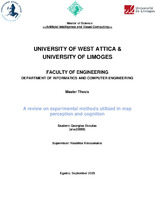A review on experimental methods utilized in map perception and cognition
Μια ανασκόπηση στις πειραματικές μεθόδους που χρησιμοποιούνται στην αντίληψη και την γνωσιακή κατανόηση των χαρτών

Μεταπτυχιακή διπλωματική εργασία
Author
Σκουλάς, Γεώργιος
Date
2023-09-28Advisor
Krassanakis, VassiliosKeywords
Map ; Map perception ; Map cognition ; Map reading ; Eye tracking ; Mouse tracking ; Electroencephalography (EEG) ; Functional Magnetic Resonance Imaging (fMRI)Abstract
This thesis explores the experimental methods employed by the cartographic community to derive quantitative data in map cognition and perception studies. From traditional tools such as questionnaires, reaction time and accuracy metrics, to modern techniques like eye and mouse tracking and neuroscience methods (EEG and fMRI), the spectrum of methods showcases the innovative evolution in understanding map user behaviors. Following this, research studies underscore the use of the aforementioned techniques in the cognitive process of map perception. Specifically, the subjects, the techniques employed in individual studies, and the results and conclusions drawn by researchers based on their experiments are discussed. A discussion is underway analyzing the studies, their subjects and methods, and outlining open questions for future research. This work also touches on potential issues arising from current research, which could form the basis for further investigation. The key conclusions and outcomes of each referenced study are noted, along with potential aggregated statistical data represented in table format, derived from these studies.
Findings highlight eye tracking as the dominant method due to its reliability and ease of use in analyzing map user-behavior and evaluating maps and geovisualizations. The method of mouse tracking has emerged as a dependable technique, while the functionality of questionnaires, as well as reaction time and accuracy metrics, has shifted to more supplementary roles. Conversely, techniques like electroencephalography (EEG) and functional magnetic resonance imaging (fMRI), though intricate, offer unparalleled insights into the spatial memory and behavior of map users. Moreover, as the world transitions from paper maps to dynamic digital formats, understanding map reading strategies across diverse platforms becomes essential. The design principles of maps, characteristics of map users, and map interfaces stand out as the most researched subjects in studies related to map perception. Innovations such as artificial intelligence (AI) and machine learning present promising opportunities, leveraging data from experimental methods to predict navigation decisions and potentially enhance map design. The emergence of Augmented Reality (AR) and Virtual Reality (VR) introduces a scope of immersive map interactions, suggesting that the future may see comprehensive studies comparing traditional maps to their AR/VR counterparts. In conclusion, the thesis encapsulates the cartographic community's engagement, from conducting in-depth research studies to developing tools and proposing innovative methodologies. The highlighted trend indicates a combination of experimental methods, signaling the potential for more integrated, multi-dimensional research in future cartographic studies.
Number of pages
113Faculty
Σχολή ΜηχανικώνAcademic Department
Τμήμα Μηχανικών Πληροφορικής και ΥπολογιστώνΤμήμα Μηχανικών Τοπογραφίας και Γεωπληροφορικής

